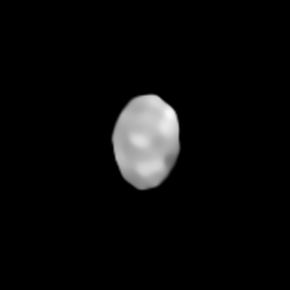 16 Psyche imaged by the Very Large Telescope's adaptive optics system in August 2019 | |
| Discovery | |
|---|---|
| Discovered by | Annibale de Gasparis |
| Discovery site | Naples Observatory |
| Discovery date | 17 March 1852 |
| Designations | |
Designation | (16) Psyche |
| Pronunciation | /ˈsaɪkiː/[1] |
Named after | Psyche (Ψυχή) |
| Main belt | |
| Adjectives | Psychean (/saɪˈkiːən/)[2] |
| Symbol | |
| Orbital characteristics[3] | |
| Epoch 13 September 2023 (JD 2460200.5) | |
| Aphelion | 3.32 AU (497 million km) |
| Perihelion | 2.53 AU (378 million km) |
| 2.92 AU (437 million km) | |
| Eccentricity | 0.1342 |
| 4.999 yr (1825.95 d) | |
| 243.16° | |
| Inclination | 3.096° |
| 150.03° | |
| 27 April 2025 | |
| 229.41° | |
| Earth MOID | 1.53 AU (229 million km) |
| Physical characteristics | |
| Dimensions | (278±5 × 232±6 × 164±4) km[4] 277 km × 238 km × 168 km[4][a] 279 × 232 × 189 km (±10%)[5] (278+4 −8 × 238+4 −6 × 171+1 −5) km[6] |
| 223±3 km[7] 222±4 km[4] 222+1 −4 km[6] | |
| Flattening | 0.41[b] |
| Volume | 5.75×106 km3 (best fit)[6] |
| Mass | (2.29±0.14)×1019 kg[8] |
Mean density | 3.977±0.253 g/cm3 |
| ~0.144 m/s2[5] | |
| ~180 m/s[5] (~600 ft/s) | |
| 4.195948±0.000001 h[5][6] | |
| Albedo | 0.15±0.03[4] 0.34±0.08 (radar)[6] |
Spectral type | Tholen = M[3] SMASS = X[3] Bus-DeMeo = Xk[9] |
| 9.22 to 12.19 | |
| 6.21[3] | |
16 Psyche (/ˈsaɪkiː/ SY-kee) is a large M-type asteroid, which was discovered by the Italian astronomer Annibale de Gasparis, on 17 March 1852 and named after the Greek goddess Psyche.[10]
The prefix "16" signifies that it was the sixteenth minor planet in order of discovery. It is the largest and most massive of the M-type asteroids, and one of the dozen most massive asteroids. It has a mean diameter of approximately 220 kilometers (140 mi) and contains about one percent of the cumulative mass of the whole asteroid belt. It was thought to be the exposed core of a protoplanet,[11] but recent observations cast doubt on that hypothesis.[8][6]
Psyche will be explored by NASA, with a spacecraft of the same name, marking the first time a manmade object will journey to a metallic asteroid, launched on 13 October 2023,[12] with an expected arrival in 2029.[13]
- ^ Cite error: The named reference
Webster-1884was invoked but never defined (see the help page). - ^ Cite error: The named reference
OED-Psycheanwas invoked but never defined (see the help page). - ^ a b c d Cite error: The named reference
JPLwas invoked but never defined (see the help page). - ^ a b c d Cite error: The named reference
Ferrais-Vernazza-etal-2020was invoked but never defined (see the help page). - ^ a b c d Cite error: The named reference
Shepard-Richardson-etal-2017was invoked but never defined (see the help page). - ^ a b c d e f Cite error: The named reference
Shepard2021was invoked but never defined (see the help page). - ^ a b Cite error: The named reference
Vernazza2021was invoked but never defined (see the help page). - ^ a b Cite error: The named reference
Elkins-Tanton_2020was invoked but never defined (see the help page). - ^ Cite error: The named reference
PDS-taxonomywas invoked but never defined (see the help page). - ^ Cite error: The named reference
Schmadel-2012-dict-mpwas invoked but never defined (see the help page). - ^ Cite error: The named reference
Bell_AsteroidsIIwas invoked but never defined (see the help page). - ^ Cite error: The named reference
Lockhart-2023-09-28was invoked but never defined (see the help page). - ^ "NASA continues Psyche asteroid mission". JPL (Press release). NASA. 28 October 2022. Archived from the original on 8 November 2022. Retrieved 28 October 2022.
Cite error: There are <ref group=lower-alpha> tags or {{efn}} templates on this page, but the references will not show without a {{reflist|group=lower-alpha}} template or {{notelist}} template (see the help page).